
Sri Lankan Air Force
|
Sri Lankan Air Force
|
| Founded in 1951 as the Royal Ceylon Air Force, today's Sri Lankan Air Force is a highly experienced, albeit small, force. Following the declaration of the current Socialist Republic of Sri Lanka, the SLAF original bread and butter was the transportation of tourists throughout the tropical island. However, the start of the long and bloody conflict with the LTTE (Liberation Tigers of Tamil Eelam or Tamil Tigers) in 1983 heralded a more belligerent epoch in the SLAF's history. In all, excluding several cease fire periods, the war would last for 26 years. Only in 2009 did the Sri Lankan Army succeed in putting down the insurgence. A big part in the succes was played by the Sri Lankan Air Force which in the meantime had learned to operate a succesion of combat aircraft and various classes of helicopters. |
|
Nowadays, the Sri Lankan fighter force is concentrated at Katunayake Air Base, the military part of Bandaranaike International Airport near the country's capital Colombo. Katunayake houses three fighter squadrons, one for each type. No. 5 sq, the first to have been established, operates the Chinese supplied Chengdu F-7's of which two versions are in use. Oldest of these are the F-7BS's four of which were delivered during 1991. As these machines are now 20 years old, they have lost their primary combat role and are now in use as Lead In Fighter Trainers for the more modern types. The 5 sq's front line is now made up of a quartet of double delta winged F-7GS's received in 2007. The fleet is supported by a single Guizhou FT-7 two seat conversion trainer.
|
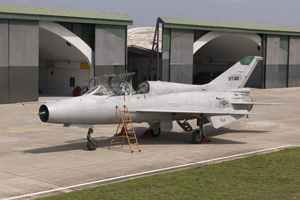
|
||
| F-7BS SFS5103, No.5 sq, Katunayake, 9 February 2011 | F-7GS SFS5105, No.5 sq, Katunayake, 9 February 2011 | FT-7, SFT1401, No 5 sq, Katunayake, 9 February 2011 |
|
The Israeli IAI Kfir was introduced during 1996 in order to give the SLAF a modern multi role aircraft. In all, the SLAF received nine Kfir C.2's as well as four C.7's which are equipped with modernised avionics. The fleet is supported by a pair of Kfir TC.2 conversion trainers. Kfir attrition has been considerable, with two C.7's being destroyed during an LTTE attack on Katunayake on 24 July 2001 and another four being lost to flying accidents, including SFM-5201 seen below.
|
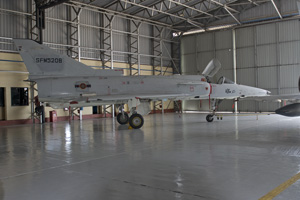
|
||
| Kfir C.2 SFM5201, No.10 sq, Katunayake, 10 February 2011 | Kfir C.2 SFM5202, No.10 sq, Katunayake, 9 February 2011 | Kfir C.7, SFM5208, No.10 sq, 9 February 2011 |
|
Apart from the F-7's and Kfirs and disregarding its small size, there is a third fighter type equipping the SLAF. This is the Mikoyan MiG.27M which was aquired from Ukraine. In all, ten have been received as heavy fighter bombers, delivery starting in 2000. Since then, three have been lost including one in the infamous LTTE attack on Katunayake mentioned above. Furthermore, there is a MiG.23UB two seat trainer available.
|
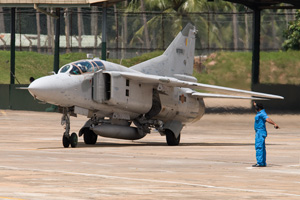
|
||
| MiG.27M SFS5304, No.12 sq, Katunayake, 9 February 2011 | MiG.27M SFS5307, No.12 sq, Katunayake, 9 February 2011 | MiG.23UB SFT1701, No.12 sq, Katunayake, 10 February 2011 |
|
Helicopters of course had a big part to play in the Eelam wars. At the start of the war, only seven Bell 206 and two SA.365C Dauphin 2 were in use. Soon added were up to 17 Bell 212's which gave stirling service as gunships and transports. For VIP transportation work, six Bell 412's were put into use during the mid eighties. Rather curiously they share the same serial number in order to confuse the terrorists! An extra pair of 206's was added, bringing the total to nine. Currently, only four Bell 206's are operational, the remainder having been written off or in the case of one example retired.
|
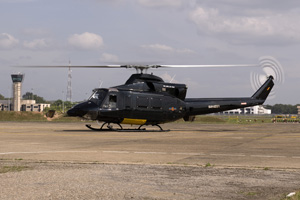
|
|
Bell 206 SHT1105, No. 7 sq, Hingarukgoda, 8 February 2011 |
Bell 212 SUH4103, Hingarukgoda, 8 February 2011 |
Bell 412 SUH4201, Katunayake, 9 February 2011 |
|
During the 1990's, the requirement for more helicopter capacity was fulfilled with Mil Mi.17's, later joined by some Mi.17-V5's.
|

|
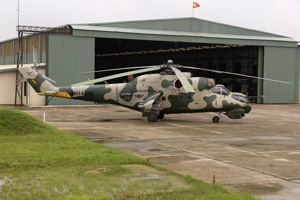
|
|
|
Mi.17 SMH4302, No. 6 sq, Anuradhapura, 8 February 2011 |
Mi.17V-5 SMH4309, No.6 sq, Katunayake, 9 February 2011 |
Mi.24V SAH4402, No. 9 sq, Hingarukgoda, February 2011 |
|
Very instrumental in bringing down the LTTE insurgency was the Mil Mi.24 and Mi.35. Up to some 25 of these powerful helicopters have seen use since 1995. Today, only five still serve.
|
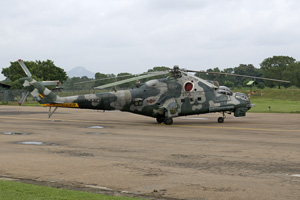
|
_SMR2201_thumb.jpg)
|
|
|
Mi.24P SAH4404, No. 9 sq, Anuradhapura, 8 February 2011 |
Mi.24V SAH4407, No. 9 sq, Hingarukgoda, 8 February 2011 |
Be.200T (HISAR) SMR2201, No. 8 sq, Ratmalana, 5 February 2011 |
|
The SLAF's transport force is an interesting mix of American, Ukranian and Chinese hardware. Colombo-Ratmalana's No. 2 sq is the heavy transport unit flying a pair of Lockheed C-130K Hercules (ex RAF Hercules C.1), alongside five Antonov An.32B medium transports. Light transport is provided No. 8 sq and their nine Chinese built Harbin Y-12 twins. The same squadron also flies a pair of Beech 200T's with one configured for HISAR (Hughes Integrated Synthetic Aperture Radar) which proved quite useful during the Civil War. The other is a pure passenger transport.
|
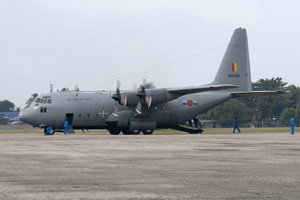
|
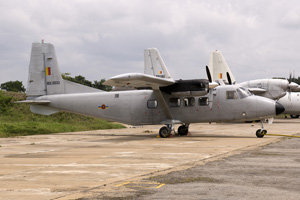
|
|
|
C-130K SCH3401, No. 2 sq, Ratmalana, 5 February 2011 |
An.32B SCM3302, No.2 sq, Ratmalana, 5 February 2011 |
Y.12 SCL3203, No.8 sq, Ratmalana, 5 February 2011 |
|
Cessna 150, SBT1201, 1 FTW, China Bay, 7 February 2011 |
PT-6, SBT1804, 1 FTW, China Bay, 7 February 2011 |
K-8, SJT1808, 1 FTW, China Bay, 7 February 2011 |
|
Future plans for the SLAF include the purchase of a number of Xian MA.60 turboprop transports from China. Plans to standardise the fighter force on Mikoyan MiG.29's appear to have been shelved, at least for the moment. It is to be hoped that Sri Lanka has now seen the last of the fighting with the LTTE. |
All pictures (c) Hans Rolink